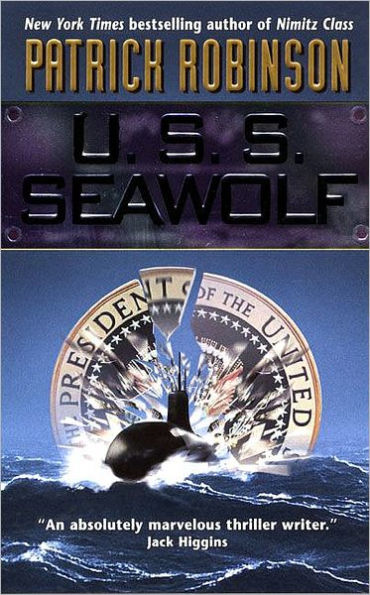Read an Excerpt
Chapter One
Friday, October 7, 2005.
Pacific Ocean. 120 miles west-southwest of
San Diego, California.The darkness crept ever westward through low, overcast skies, and the gusting northwest breeze whipped white crests onto the long wavetops. At this time of the evening, in the 20 minutes of no-man's time between sunset and nightfall streaming in over the immense ocean, the Pacific takes on a deeply malevolent mantle. Its awesome troughs and rising waves glisten darkly in the last of the light. There's no bright, friendly phosphorescence in the bottomless waters out here. To stare down at the black seascape, even from the safe reassuring deck of a warship, is to gaze into the abyss. Oh Lord, your ocean is so vast, and my boat is so small.
Eight hundred feet into the abyss, way beneath the twilight melancholy of the surface, USS Seawolf thundered forward, making almost 40 knots, somewhere south of the Murray Fracture Zone. The 9,000-ton United States Navy attack submarine was heavily into her months of sea trials, following a massive three-year overhaul. Seawolf was not at war, but a passing whale could have been forgiven for thinking she was. Forty knots is one hen of a speed for a 350-foot-long submarine. But Seawolf had been built for speed, constructed to lead the underwater cavalry of the Navy, anywhere, anytime. And right now she was in deep submergence trials, testing her systems, flexing her muscles in the desolate black wilderness of America's western ocean.
Powered by two 45,000—horsepower turbines and a state-of-the-art Westinghouse nuclear reactor, Seawolf was the mostexpensive submarine ever built. Too expensive. The Navy was permitted to build only three of her class—Connecticut and USS Jimmy Carter were the others-before budget restraints caused the cancellation of these jet-black emperors of the deep. Over a billion dollars had been spent on her research and development before Seawolf was commissioned in 1997.
Now, after her multimillion-dollar overhaul, the submarine was, without question, the finest underwater warship in the world, the fastest, quietest nuclear boat. At 20 knots there was nothing to be heard beyond the noise of the water parted by the bulk of her hull. She could pack a ferocious wallop, too. Seawolf was armed with a phalanx of Tomahawk land-attack missiles that could travel at almost 1,000 mph to a target 1,400 miles distant. She could unleash a missile with a 454-kilogram warhead and hit an enemy ship 250 miles away. She bristled with eight 26-inch torpedo tubes, launching bases for big wire-guided Gould Mark 48s, homing if necessary to 27 miles. Highly effective, these weapons offered a kill probability of 50 percent, second only to the British Spearfish.
Seawolf carried sonars estimated as three times more effective than even the most advanced Los Angeles—class boats. She used both TB16 and TB29 surveillance and towed arrays. For active close-range detection she used the BQS 24 system. Her electronic support measures (ESM) were nothing short of sensational. Any ship anywhere within 50 miles could not move, communicate, or even activate its sonar or radar without Seawolf hearing every last telltale sound. She was not a gatherer of clandestine information, she was an electronic vacuum cleaner, the last word in the U.S. Navy's most secretive, private, advanced research.
And Captain Judd Crocker was darned proud of her. "Never been a submarine to match this one," he would say. "And I doubt there ever will be. Not in my lifetime."
And that was worthwhile praise. The son of a surface ship admidral, grandson of another, he had been born into a family of Cape Cod yacht racers, and he had been around boats of all sizes since he could walk. He never inherited his father's unique talents as a helmsman, but he was good, better than most, though destined always to be outclassed by the beady-eyed Admiral Nathaniel Crocker.
Judd was 40 years old now. A lifelong submariner, he had served as Seawolf' s first Executive Officer back in 1997 and commanded her five years later. He received his promotion to Captain just before she came out of overhaul, and resumed command in the high summer of the year 2005.
That was the culmmination of all his boyhood dreams, and the culmination of a plan he had made at the age of 15 when his father had taken him out to watch the annual race from Newport around Block Island and back. The admiral was not racing himself, but he and Judd were guests on board one of the New York Yacht Club committee boats. It was a day of intermittent fog out in the bay, and several competitors had trouble navigating.
Even Judd's committee boat was a little wayward in the early afternoon, straying too far southwest of the island, about a halfmile from the point of approach of a 7,000-ton Los Angeles-class submarine rolling past on the surface toward the Groton submarine base. The sun was out at the time, and Judd had watched through binoculars one of the great black warhorses of the U.S. Navy. He was transfixed by the sight of her, noting the number 690 painted on her sail. He almost died of excitement when a couple of the officers on the bridge waved across the water to the committee boat. And he had stared after the homeward-bound USS Philadelphia long after she became too small to identify on the horizon.



